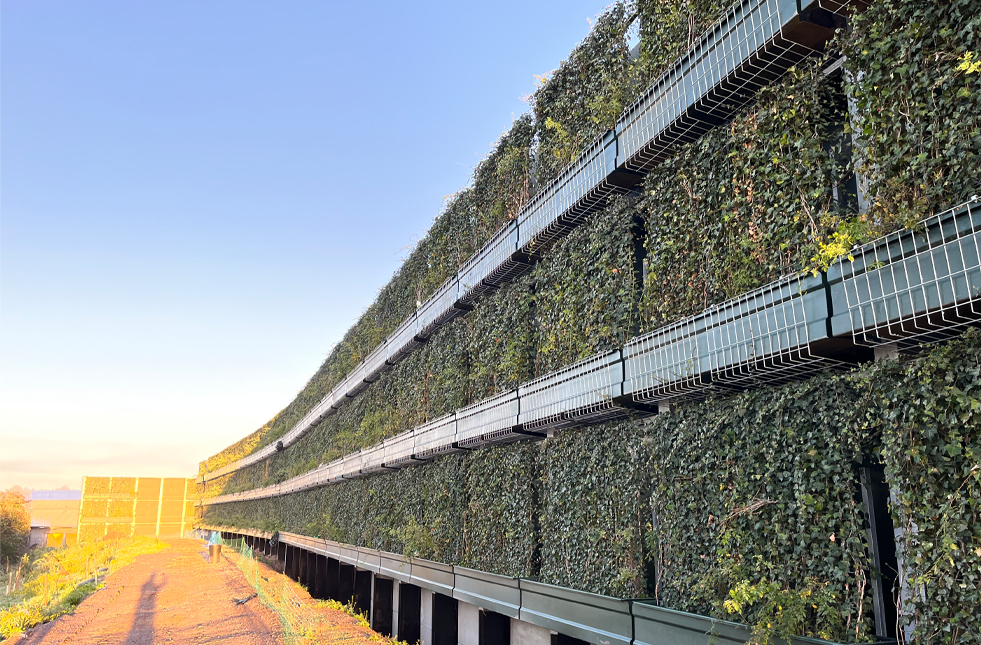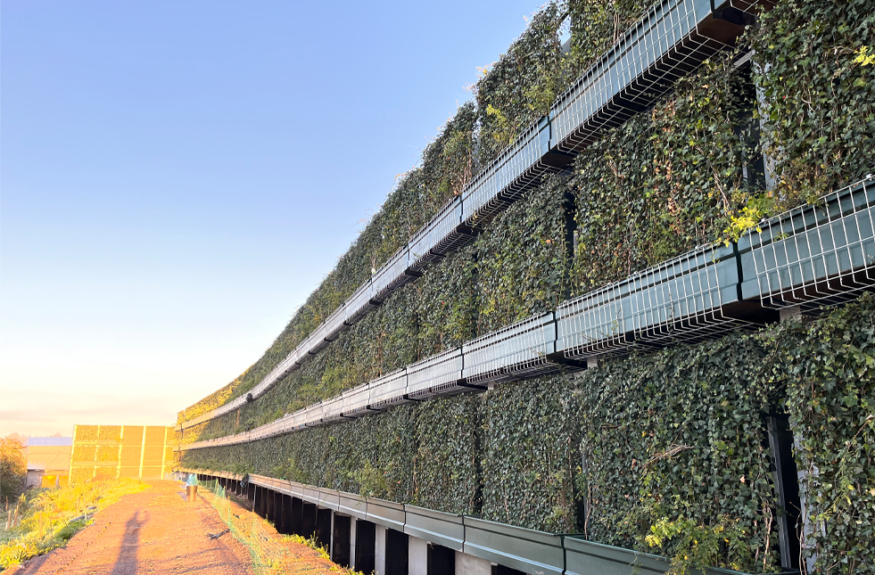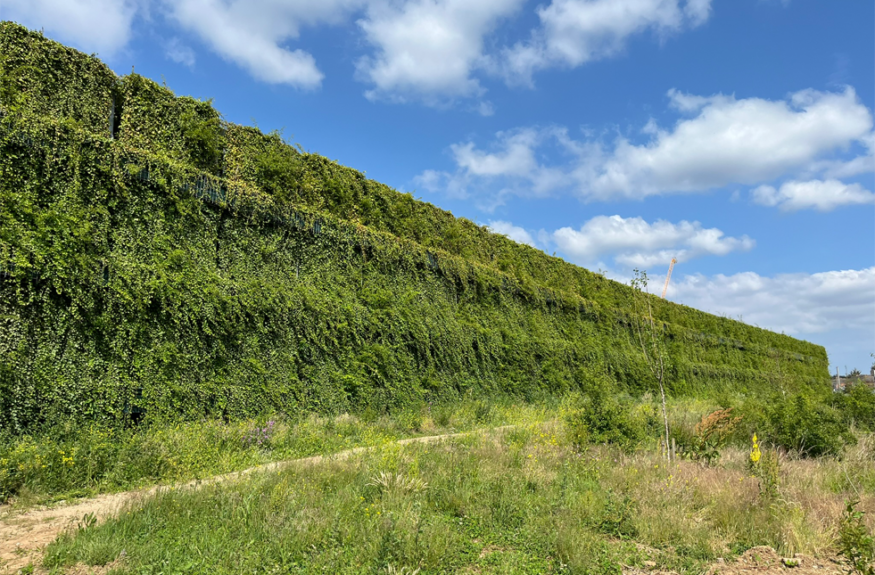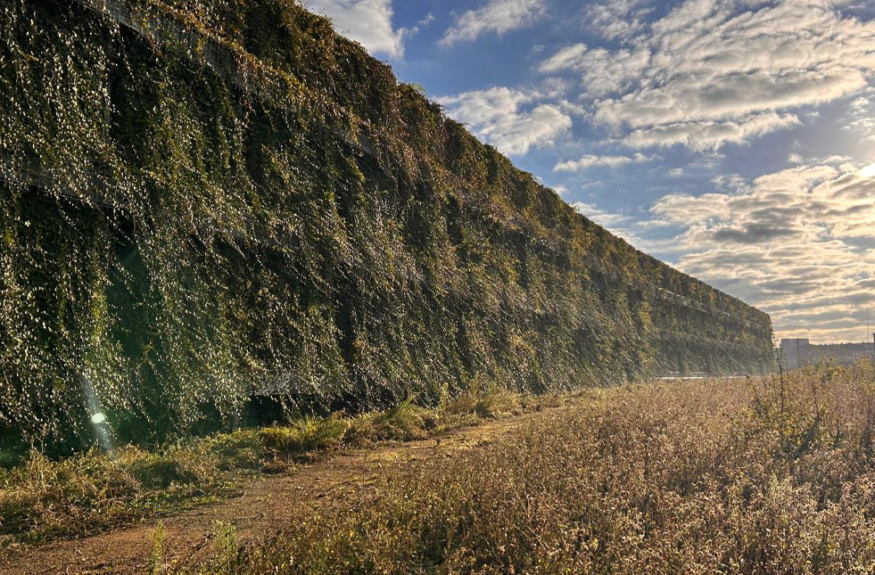Case study: Inleaf create 1,000m2 living wall as part of London acoustic screen project

 Read time: 6mins
Read time: 6mins- Share
- Inleaf installed one of the largest vertical greening projects in the UK
- Using blanket coverage of evergreen Ivy, with additional flowering plants
- The living wall is part of a large-scale acoustic screen to reduce noise
The Start of the Cricklewood Acoustic Wall Project
Inleaf have worked to create one of the UK’s largest living walls in Cricklewood, London. The design called for a living wall to be added to a 115m long and 10-15m tall acoustic screen, to reduce noise from a nearby industrial site.
Working with a specialist engineering company through the concept and design stages over 18-months, we advised and designed, supplied and installed the vertical greening and irrigation aspects that form an integral part of the scheme.
The Inleaf team’s involvement included plant selection, design and assistance with the overall technical approach. This very bespoke project required us to balance multiple considerations, including positive visual appearance, interface with the other aspects of the scheme, effective irrigation and the longevity of the installation as a whole. These were all meticulously planned from the initial concept, to construction and into the ongoing maintenance of the scheme.
The finished installation provides the double-benefit of effectively reducing noise and providing an attractive and biodiverse benefit to the local area.
The living wall is primarily made-up of pre-grown Ivy screens.. These arrive on site with a base level of coverage that gives the installation an immediate greening effect and reduces the time for plants to become fully established. With time, the ivy will continue to grow to further improve the visual appearance as the plants thrive.
Living Wall Construction
The living wall in Cricklewood was a team effort between Inleaf, the engineers who designed and provided the acoustic panels and underlying structure, and other specialist contractors. We installed 368 individual Ivy screens to create a wall that’s over 1,000m². The Ivy screens make up the main plant coverage, with flowering plants such as dog rose and honeysuckle adding variety throughout the seasons. These plants bloom from spring to early autumn, helping attract wildlife like birds and bees, which boosts the area’s biodiversity.
Why rain water isn’t enough
For the living wall to thrive we couldn’t rely on rainwater. So, we created a bespoke irrigation system to ensure it gets the right amount of water and nutrients. The system works through a network of pipes that drip-feed water and fertilisers to each of the 368 Ivy panels. 30 individual water-level sensors – placed in the living wall ensure the water usage is optimised.
This system is crucial for the living wall’s long-term health. Since the wall needs more water than falls from the sky, especially during hot, dry seasons, the irrigation system steps up and provides the water for the plants. It’s a key part of supporting plant growth and maximizing the environmental benefits, like better air quality and more biodiversity.
Living wall maintenance
Ongoing maintenance is essential to ensure continued health and attractive appearance of this London living wall.
Proactive maintenance of the irrigation system is extremely important, too. Regular checks are carried out to make sure it’s functioning properly including remote monitoring of the computerised controller and adjustments based on seasonality and site conditions. This bespoke irrigation system ensures that all 368 Ivy screens get the correct amount of water and nutrients. Integrated moisture sensors within the wall ensure optimum and efficient water usage can be achieved.
Overall, maintaining the living wall requires a balance of horticulture expertise, engineering and project management. This ongoing effort ensures the wall stays strong and visually impactful, and that it continues to offer all its environmental, social, and economic benefits to the local area.
Why an Acoustic Green Wall?
Acoustic walls are designed to reduce noise pollution, creating a more peaceful atmosphere in urban spaces. This is valuable in areas with heavy traffic or industrial activities, where noise disrupts daily life and can affect human health. Installing acoustic wall panels can increase the sound quality and comfort within this urban space.
Adding a living wall to the acoustic screen provides extra visual and biodiversity benefits to the scheme too. Living walls enhance the air quality through carbon sequestration and the release of oxygen. They can also help to cool urban areas, reducing the urban heat island effect. Additionally, the presence of plants increases biodiversity, creating habitats for wildlife, which are essential for pollination.
Living walls also offer an aesthetic upgrade that can bring green spaces to built-up areas. This enhances the visual appeal, making them more inviting and pleasant. The integration of plants is a nature-based solution that supports sustainable living, reduces urban particulate matter pollution, and promotes human health. Choosing to add vertical greening to an acoustic screen solution can achieve noise reduction and create a healthier, more sustainable urban environment.
Next Steps...
Got a project in mind?
We’re here to help.
Fill in the form below and one of our team will get in touch.










